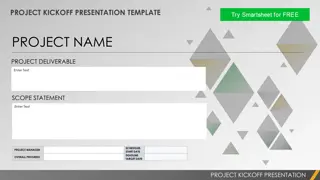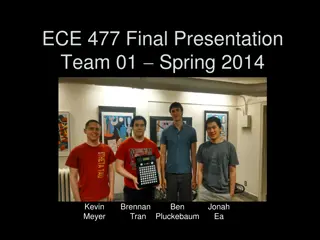
Skee Ball Accessibility Project Overview and Design Challenges
Explore the creation of a scaled-down Skee Ball game focused on user accessibility, featuring a motorized launching mechanism, joystick control, ultrasonic sensors, and individual team contributions. Discover the design challenges faced and innovative solutions implemented.
Download Presentation

Please find below an Image/Link to download the presentation.
The content on the website is provided AS IS for your information and personal use only. It may not be sold, licensed, or shared on other websites without obtaining consent from the author. If you encounter any issues during the download, it is possible that the publisher has removed the file from their server.
You are allowed to download the files provided on this website for personal or commercial use, subject to the condition that they are used lawfully. All files are the property of their respective owners.
The content on the website is provided AS IS for your information and personal use only. It may not be sold, licensed, or shared on other websites without obtaining consent from the author.
E N D
Presentation Transcript
ECE 477 FINAL REVIEW: TEAM #1
OUTLINE Project Overview Block Diagram Design Challenges Individual Contributions Project Video Demonstration Questions
PROJECT OVERVIEW Premise: A scaled-down version of the classic game, Skee Ball, designed to improve user accessibility. Motorized Launching Mechanism: Uses a push- button where the duration of the press influences the launch force. Joystick: A joystick adjusts the launching mechanism s orientation. Ultrasonic Sensors: 5 different ultrasonic sensors in each scoring hole to detect ball. Upon Sensor Detection: Score will update on LCD display and confirmation sound will play via speaker. One Game Mode: 3 chances to score
DESIGN CHALLENGES Design Challenge Launching Mechanism Challenge: Designing a mechanism to launch the ball up the ramp with limited components and no prior mechanical design experience. Why: Needed to choose an effective setup (horizontal vs. vertical flywheel) while working with only one motor and unfamiliar components. Solution: Selected a vertical flywheel design with one powered wheel, allowing simpler implementation and reliable launches after iterative testing.
DESIGN CHALLENGES Design Challenge Building the Arcade Body Challenge: Finding or creating a skee-ball style chassis that fit our components and budget constraints. Why: Prebuilt machines were too expensive or not compatible with our custom hardware integration. Solution: Built our own structure out of wood at the Bechtel Design Center, giving full control over dimensions and easier integration of all components.
INDIVIDUAL CONTRIBUTIONS Andrew Cali Andrew Cali Ball launching mechanism design PCB Design Soldering Launch Testing and Calibration
INDIVIDUAL CONTRIBUTIONS David Fall David Fall Component drivers (embedded software) Integration code (embedded software) PCB Design Packaging Team Management
INDIVIDUAL CONTRIBUTIONS Jennifer Ferguson Jennifer Ferguson Audio Transmission using I2S Packaging Soldering Integrating final hardware in packaging
INDIVIDUAL CONTRIBUTIONS Madeline Flanagan Madeline Flanagan Joystick and servo motor control Machine design & packaging Soldering Assembly & integration of components
PROJECT DEMONSTRATION 1. PSDR #1: (Hardware): An ability for a microcontroller to write text to an LCD character display using the SPI protocol. 2. PSDR #2: (Hardware): An ability for a microcontroller to transmit WAV file data to an amplifier breakout using the I2S protocol. 3. PSDR #3: (Hardware): An ability for a microcontroller to drive a DC motor with variable power using PWM signal generation. 4. PSDR #4: (Hardware): An ability for a microcontroller to read from an array of ultrasonic sensors via GPIO pins. 5. PSDR #5: (Hardware): An ability for a microcontroller to convert analog input from an external joystick to a digital signal using analog to digital conversion.
PROJECT DEMONSTRATION VIDEO https://www.youtube.com/watch?v=028JnDdOcIg



















